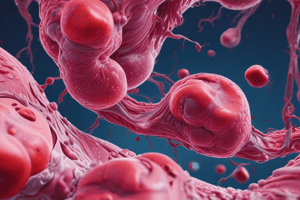Podcast
Questions and Answers
What post-translational modification is crucial for converting PIVKA factors into their biologically active forms?
What post-translational modification is crucial for converting PIVKA factors into their biologically active forms?
What is the primary function of gamma-carboxylated glutamic acid residues in vitamin K-dependent proteins?
What is the primary function of gamma-carboxylated glutamic acid residues in vitamin K-dependent proteins?
How does Warfarin induce a functional vitamin K deficiency?
How does Warfarin induce a functional vitamin K deficiency?
Which of the following laboratory findings is typically associated with vitamin K deficiency?
Which of the following laboratory findings is typically associated with vitamin K deficiency?
Signup and view all the answers
What is the recommended initial intravenous dose of vitamin K for treating active bleeding or prior to liver biopsy in a patient with vitamin K deficiency?
What is the recommended initial intravenous dose of vitamin K for treating active bleeding or prior to liver biopsy in a patient with vitamin K deficiency?
Signup and view all the answers
Which of the following is a direct consequence of biliary obstruction in liver disease?
Which of the following is a direct consequence of biliary obstruction in liver disease?
Signup and view all the answers
In severe hepatocellular disease, what changes are MOST likely observed in coagulation factors?
In severe hepatocellular disease, what changes are MOST likely observed in coagulation factors?
Signup and view all the answers
What is dysfibrinogenemia, as it relates to liver disease?
What is dysfibrinogenemia, as it relates to liver disease?
Signup and view all the answers
How does decreased thrombopoietin production from the liver contribute to hemostatic abnormalities?
How does decreased thrombopoietin production from the liver contribute to hemostatic abnormalities?
Signup and view all the answers
Why does hypersplenism, associated with portal hypertension, frequently result in thrombocytopenia?
Why does hypersplenism, associated with portal hypertension, frequently result in thrombocytopenia?
Signup and view all the answers
What is the MOST likely mechanism by which damaged liver cells can trigger disseminated intravascular coagulation (DIC)?
What is the MOST likely mechanism by which damaged liver cells can trigger disseminated intravascular coagulation (DIC)?
Signup and view all the answers
How does Warfarin induce vitamin K deficiency?
How does Warfarin induce vitamin K deficiency?
Signup and view all the answers
What are the MOST common causes of vitamin K deficiency in adults and children?
What are the MOST common causes of vitamin K deficiency in adults and children?
Signup and view all the answers
Flashcards
PIVKA Factors
PIVKA Factors
Prothrombin-induced vitamin K absence factors that require carboxylation for activation.
Gamma-carboxylation
Gamma-carboxylation
Modification of glutamic acid residues that allows binding of calcium ions in proteins.
Vitamin K epoxide
Vitamin K epoxide
An oxidized form of vitamin K involved in the carboxylation process.
Vitamin K deficiency
Vitamin K deficiency
Signup and view all the flashcards
Prothrombin complex concentrate
Prothrombin complex concentrate
Signup and view all the flashcards
Liver Disease
Liver Disease
Signup and view all the flashcards
Biliary Obstruction
Biliary Obstruction
Signup and view all the flashcards
Thrombocytopenia
Thrombocytopenia
Signup and view all the flashcards
Dysfibrinogenemia
Dysfibrinogenemia
Signup and view all the flashcards
PIVKA
PIVKA
Signup and view all the flashcards
Malabsorption
Malabsorption
Signup and view all the flashcards
Warfarin
Warfarin
Signup and view all the flashcards
Study Notes
Liver Disease and Vitamin K Deficiency
- Liver disease contributes to multiple haemostatic abnormalities
- Biliary obstruction impairs vitamin K absorption, decreasing the synthesis of factors II, VII, IX, and X by liver cells.
- Severe hepatocellular disease additionally reduces levels of factor V and fibrinogen, and increases plasminogen activator.
- Functional abnormality of fibrinogen (dysfibrinogenaemia) is common in liver disease patients.
- Decreased thrombopoietin production from the liver leads to thrombocytopenia.
- Hypersplenism associated with portal hypertension frequently causes thrombocytopenia.
- Disseminated intravascular coagulation (DIC) might be linked to thromboplastin release from damaged liver cells and reduced antithrombin, protein C, and a2-antiplasmin levels.
- Impaired removal of activated clotting factors and increased fibrinolytic activity also contribute to the prothrombotic state often seen in liver disease.
Vitamin K
- Vitamin K is fat-soluble and obtained from green vegetables and gut bacteria.
- Newborn vitamin K deficiency may arise due to liver immaturity, lack of gut bacteria synthesis, and low breast milk levels.
- Children and adults may develop vitamin K deficiency due to poor diet, malabsorption, or drug inhibition (e.g., warfarin).
- Warfarin decreases the functional activity of factors II, VII, IX, X, and proteins C and S, though immunological tests may show normal levels.
- Non-functional proteins formed in vitamin K absence are called PIVKA proteins.
- Vitamin K-dependent protein activation involves carboxylation of glutamic acid residues.
- Gamma-carboxylated glutamic acid binds calcium ions, changing the shape of vitamin K-dependent proteins.
- This exposes hydrophobic regions for phospholipid binding.
- Vitamin K is cycled back to its reduced form via VKORC-1 reductase.
- Warfarin inhibits vitamin K epoxide reductase, causing dysfunction.
Vitamin K Deficiency in Children or Adults
- Vitamin K deficiency, often resulting from obstructive jaundice, pancreatic disease, or small bowel disease, can cause bleeding disorders.
- Diagnosis is confirmed by prolonged prothrombin time (PT) and activated partial thromboplastin time (APTT).
- Low plasma levels of factors II, VII, IX, and X are also observed.
Treatment
- Prophylaxis: 5 mg of vitamin K orally daily.
- Active bleeding or pre-liver biopsy: 10 mg vitamin K slowly intravenously.
- Correction typically occurs within 6 hours.
- Repeat dose may be needed over the following 2 days.
- Rapid correction is possible through prothrombin complex concentrate infusion.
Studying That Suits You
Use AI to generate personalized quizzes and flashcards to suit your learning preferences.
Related Documents
Description
This quiz covers the relationship between liver disease and vitamin K deficiency, focusing on the impact on hemostasis and various clotting factors. It explores how liver dysfunction can lead to significant hematological abnormalities, such as thrombocytopenia and dysfibrinogenemia, and the roles of vitamin K in this context.




